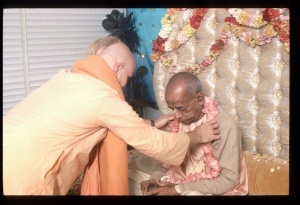CC Adi 7.37 (1975): Difference between revisions
(Vanibot #0027: CCMirror - Mirror CC's 1996 edition to form a basis for 1975) |
(Vanibot #0020: VersionCompareLinker - added a link to the Version Compare feature) |
||
| Line 2: | Line 2: | ||
<div style="float:left">'''[[Sri Caitanya-caritamrta (1975)|Śrī Caitanya-caritāmṛta (1975)]] - [[CC Adi (1975)|Ādi-līlā]] - [[CC Adi 7 (1975)|Chapter 7: Lord Caitanya in Five Features]]'''</div> | <div style="float:left">'''[[Sri Caitanya-caritamrta (1975)|Śrī Caitanya-caritāmṛta (1975)]] - [[CC Adi (1975)|Ādi-līlā]] - [[CC Adi 7 (1975)|Chapter 7: Lord Caitanya in Five Features]]'''</div> | ||
<div style="float:right">[[File:Go-previous.png|link=CC Adi 7.36 (1975)|Ādi-līlā 7.36]] '''[[CC Adi 7.36 (1975)|Ādi-līlā 7.36]] - [[CC Adi 7.38 (1975)|Ādi-līlā 7.38]]''' [[File:Go-next.png|link=CC Adi 7.38 (1975)|Ādi-līlā 7.38]]</div> | <div style="float:right">[[File:Go-previous.png|link=CC Adi 7.36 (1975)|Ādi-līlā 7.36]] '''[[CC Adi 7.36 (1975)|Ādi-līlā 7.36]] - [[CC Adi 7.38 (1975)|Ādi-līlā 7.38]]''' [[File:Go-next.png|link=CC Adi 7.38 (1975)|Ādi-līlā 7.38]]</div> | ||
{{CompareVersions|CC|Adi 7.37|CC 1975|CC 1996}} | |||
{{RandomImage}} | {{RandomImage}} | ||
==== TEXT 37 ==== | ==== TEXT 37 ==== | ||
| Line 18: | Line 17: | ||
<div class="synonyms"> | <div class="synonyms"> | ||
aparādha—offense; kṣamāila—excused; ḍubila—merged into; | aparādha—offense; kṣamāila—excused; ḍubila—merged into; prema-jale—in the ocean of love of Godhead; kebā—who else; eḍāibe—will go away; prabhura—the Lord's; prema—loving; mahā-jāle—network. | ||
</div> | </div> | ||
| Line 32: | Line 31: | ||
<div class="purport"> | <div class="purport"> | ||
Śrī Caitanya Mahāprabhu was an ideal ācārya. An ācārya is an ideal teacher who knows the | Śrī Caitanya Mahāprabhu was an ideal ācārya. An ācārya is an ideal teacher who knows the purpose of the revealed scriptures, behaves exactly according to their injunctions and teaches his students to adopt these principles also. As an ideal ācārya, Śrī Caitanya Mahāprabhu devised ways to capture all kinds of atheists and materialists. Every ācārya has a specific means of propagating his spiritual movement with the aim of bringing men to Kṛṣṇa consciousness. Therefore, the method of one ācārya may be different from that of another, but the ultimate goal is never neglected. Śrīla Rūpa Gosvāmī recommends: | ||
:tasmāt kenāpy upāyena | |||
:manaḥ kṛṣṇe niveśayet | |||
:sarve vidhi-niṣedhā syur | |||
:etayor eva kiṅkarāḥ | |||
An ācārya should devise a means by which people may somehow or other come to Kṛṣṇa consciousness. First they should become Kṛṣṇa conscious, and all the prescribed rules and regulations may later gradually be introduced. In our Kṛṣṇa consciousness movement we follow this policy of Lord Śrī Caitanya Mahāprabhu. For example, since boys and girls in the Western countries freely intermingle, special concessions regarding their customs and habits are necessary to bring them to Kṛṣṇa consciousness. The ācārya must devise a means to bring them to devotional service. Therefore, although I am a sannyāsī I sometimes take part in getting boys and girls married, although in the history of sannyāsa no sannyāsī has personally taken part in marrying his disciples. | An ācārya should devise a means by which people may somehow or other come to Kṛṣṇa consciousness. First they should become Kṛṣṇa conscious, and all the prescribed rules and regulations may later gradually be introduced. In our Kṛṣṇa consciousness movement we follow this policy of Lord Śrī Caitanya Mahāprabhu. For example, since boys and girls in the Western countries freely intermingle, special concessions regarding their customs and habits are necessary to bring them to Kṛṣṇa consciousness. The ācārya must devise a means to bring them to devotional service. Therefore, although I am a sannyāsī I sometimes take part in getting boys and girls married, although in the history of sannyāsa no sannyāsī has personally taken part in marrying his disciples. | ||
</div> | </div> | ||
Latest revision as of 19:26, 26 January 2020

A.C. Bhaktivedanta Swami Prabhupada
TEXT 37
- aparādha kṣamāila, ḍubila prema-jale
- kebā eḍāibe prabhura prema-mahājāle
SYNONYMS
aparādha—offense; kṣamāila—excused; ḍubila—merged into; prema-jale—in the ocean of love of Godhead; kebā—who else; eḍāibe—will go away; prabhura—the Lord's; prema—loving; mahā-jāle—network.
TRANSLATION
Lord Caitanya excused them all, and they merged into the ocean of devotional service, for no one can escape the unique loving network of Śrī Caitanya Mahāprabhu.
PURPORT
Śrī Caitanya Mahāprabhu was an ideal ācārya. An ācārya is an ideal teacher who knows the purpose of the revealed scriptures, behaves exactly according to their injunctions and teaches his students to adopt these principles also. As an ideal ācārya, Śrī Caitanya Mahāprabhu devised ways to capture all kinds of atheists and materialists. Every ācārya has a specific means of propagating his spiritual movement with the aim of bringing men to Kṛṣṇa consciousness. Therefore, the method of one ācārya may be different from that of another, but the ultimate goal is never neglected. Śrīla Rūpa Gosvāmī recommends:
- tasmāt kenāpy upāyena
- manaḥ kṛṣṇe niveśayet
- sarve vidhi-niṣedhā syur
- etayor eva kiṅkarāḥ
An ācārya should devise a means by which people may somehow or other come to Kṛṣṇa consciousness. First they should become Kṛṣṇa conscious, and all the prescribed rules and regulations may later gradually be introduced. In our Kṛṣṇa consciousness movement we follow this policy of Lord Śrī Caitanya Mahāprabhu. For example, since boys and girls in the Western countries freely intermingle, special concessions regarding their customs and habits are necessary to bring them to Kṛṣṇa consciousness. The ācārya must devise a means to bring them to devotional service. Therefore, although I am a sannyāsī I sometimes take part in getting boys and girls married, although in the history of sannyāsa no sannyāsī has personally taken part in marrying his disciples.